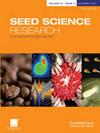质膜H+- atp酶的激活和活性:蚕豆种子萌发的关键事件
IF 2.1
3区 生物学
Q2 PLANT SCIENCES
引用次数: 3
摘要
摘要蚕豆种子吸收过程中考虑了质膜H+-ATP酶的调节,其显著特征是通过细胞伸长发芽,而有丝分裂活性开始较晚。已知酶激活先于发芽,因为它提供了从细胞质到细胞壁的H+离子流出,这有利于细胞壁的修饰和松动,这是细胞伸长开始的先决条件。免疫化学证实了在吸收胚胎轴中存在一种酶。用pH计记录H+离子流出,作为环境溶液通过胚胎轴酸化5分钟。酶的激活及其随后的活性以不同的方式调节。酶的激活是由水合作用驱动的,当含水量增加到55%的阈值水平(以新鲜重量为基础)时,酶就开始激活。该值通过在不同渗透电位下在渗透保持剂聚乙二醇6000存在下的吸胀来确认。活化不依赖于吲哚乙酸或脱落酸处理。水合引发的酶激活有利于种子的快速发芽及其与土壤水势的对应性。激活后的酶活性被10−5–10−7 M脱落酸抑制60-70%,而吲哚乙酸没有发挥作用。质膜H+-ATP酶活性的调节可能是通过该酶与14-3-3蛋白和存在于吸收轴中的内源性融合蛋白的相互作用来实现的。本文章由计算机程序翻译,如有差异,请以英文原文为准。
Activation and activity of plasma membrane H+-ATPase: key events in germinating Vicia faba seeds
Abstract The regulation of plasma membrane H+-ATPase was considered in imbibing Vicia faba seeds, a distinctive feature of which is germination by cell elongation, whereas the mitotic activity starts later. The enzyme activation is known to precede germination because it provides H+ ion efflux from the cytoplasm to cell walls which favours their modification and loosening, being the prerequisites of cell elongation commencement. The presence of an enzyme in imbibing embryo axes was confirmed immunochemically. H+ ion efflux was recorded with a pH-meter as acidification of ambient solution by the embryonic axes for 5 min. The activation of the enzyme and its subsequent activity are regulated in different ways. Enzyme activation is hydration-driven, it starts when water content increases up to the threshold level of 55% (fresh weight basis). This value was confirmed by imbibition in the presence of the osmoticum polyethylene glycol 6000, at various osmotic potentials. The activation does not depend on indolylacetic or abscisic acid treatment. Hydration-triggered activation of the enzyme favours rapid seed germination and its correspondence to the soil water potential. Enzyme activity after its activation is inhibited by 60–70% by 10−5–10−7 M abscisic acid, whereas indolylacetic acid exerted no effect. The regulation of plasma membrane H+-ATPase activity is presumably accomplished by the interaction of the enzyme with 14-3-3 proteins and endogenous fusicoccin, present in imbibing axes.
求助全文
通过发布文献求助,成功后即可免费获取论文全文。
去求助
来源期刊

Seed Science Research
生物-植物科学
CiteScore
3.60
自引率
4.80%
发文量
23
审稿时长
>12 weeks
期刊介绍:
Seed Science Research, the official journal of the International Society for Seed Science, is a leading international journal featuring high-quality original papers and review articles on the fundamental aspects of seed science, reviewed by internationally distinguished editors. The emphasis is on the physiology, biochemistry, molecular biology and ecology of seeds.
 求助内容:
求助内容: 应助结果提醒方式:
应助结果提醒方式:


